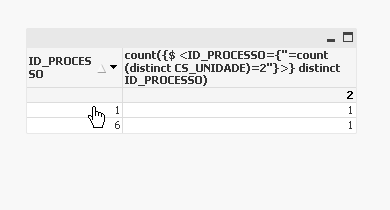Unlock a world of possibilities! Login now and discover the exclusive benefits awaiting you.
- Qlik Community
- :
- Forums
- :
- Groups
- :
- Location and Language
- :
- Brasil
- :
- Re: Cruzamento de dados comuns
- Subscribe to RSS Feed
- Mark Topic as New
- Mark Topic as Read
- Float this Topic for Current User
- Bookmark
- Subscribe
- Mute
- Printer Friendly Page
- Feature this Topic
- Mark as New
- Bookmark
- Subscribe
- Mute
- Subscribe to RSS Feed
- Permalink
- Report Inappropriate Content
Cruzamento de dados comuns
Pessoal, sou novo no fórum e comecei minhas experiências com o QlikView aqui no meu local de trabalho.
Estou com algumas planilhas estruturadas com OS seguintes campos:
ID_PROCESSO e CS_UNIDADE
No campo CS_UNIDADE posso ter duas opções "Unidade A" e "Unidade B".
Quero saber quantos são os processos em comum nas duas unidades, ou seja, quantos processos pertencem à "Unidade A" e que também estão na Lista da "Unidade B".
Obs: ID_PROCESSO é um campo chave.
Alguém pode me Ajudar?
Desde agradeço já,
Accepted Solutions
- Mark as New
- Bookmark
- Subscribe
- Mute
- Subscribe to RSS Feed
- Permalink
- Report Inappropriate Content
Hope to understand, I tried woth these test data
U:
load * inline [
ID_PROCESSO, CS_UNIDADE
1,Unit a
1,Unit b
2,Unit a
3,Unit b
4,Unit a
5,Unit b
6,Unit a
6,Unit b
];
in a straight table chart the result is

- Mark as New
- Bookmark
- Subscribe
- Mute
- Subscribe to RSS Feed
- Permalink
- Report Inappropriate Content
Hope to understand, I tried woth these test data
U:
load * inline [
ID_PROCESSO, CS_UNIDADE
1,Unit a
1,Unit b
2,Unit a
3,Unit b
4,Unit a
5,Unit b
6,Unit a
6,Unit b
];
in a straight table chart the result is

- Mark as New
- Bookmark
- Subscribe
- Mute
- Subscribe to RSS Feed
- Permalink
- Report Inappropriate Content
You just created a graphic with an advanced expression ?
- Mark as New
- Bookmark
- Subscribe
- Mute
- Subscribe to RSS Feed
- Permalink
- Report Inappropriate Content
a straight table chart with
dimension ID_PROCESSO
expression count({$ <ID_PROCESSO={"=count(distinct CS_UNIDADE)=2"}>} distinct ID_PROCESSO)
- Mark as New
- Bookmark
- Subscribe
- Mute
- Subscribe to RSS Feed
- Permalink
- Report Inappropriate Content
and if I add two new columns (REU and AUTOR).. How can I filter data that has "PGU" in REU ?
- Mark as New
- Bookmark
- Subscribe
- Mute
- Subscribe to RSS Feed
- Permalink
- Report Inappropriate Content
Acho que pode fazer assim:
if( unidade = 'A' and unidade = 'B', count (cliente)) as contador
- Mark as New
- Bookmark
- Subscribe
- Mute
- Subscribe to RSS Feed
- Permalink
- Report Inappropriate Content
A solução do maxgro deu certinho.. queria resolver este outro problema..
A propósito, onde acho um material legal pra aprender sobre expressões avançadas ?
- Mark as New
- Bookmark
- Subscribe
- Mute
- Subscribe to RSS Feed
- Permalink
- Report Inappropriate Content
A propósito, onde acho um material legal pra aprender sobre expressões avançadas ?